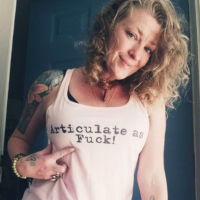My jaw twitches.
Something inside me needs support. Something needs expressing.
I was awoken by a feeling that, up until recently, I called anxiety. I’m now thinking of it as vitality. It’s me—vivid, tender, and alive, but slightly distorted.
Whenever I feel this sense of restlessness or stagnation, I have learned to ask myself:
“What do I not want to feel right now?”
Excitement.
Arousal.
If I fully feel these feelings, I have to take responsibility for them. I have to own them and I have to be here—in my body—for them, and with myself.
I know I want this, need this. Yet, I am scared.
There are multiple things that need tending. First and foremost, the sensations that are arising—waves and ripples, aches and yearnings. There are my inner selves of varying ages and even sexes. There is my inner child (or children), my inner feminine, and my inner masculine.
There is the retreat I am hosting, a new adventure for myself and business.
Last, but not least, there is a man who I am wildly attracted to, who I care for. Whose care I feel. This shared attention between us brings wild longing as well as my neuroses to the surface.
My inner world is rich and deep. It has become an oasis as I have excavated and explored it. It was once darker, a place I used to hide and escape. Now it is more of a wonderland full of resources and valuable information.
Last year I had a vision of a small child clinging to a rock in the middle of a raging river. This was how I was seeing commitment at the time. It was terrifying. The feelings my vision evoked matched the physical sensations that I was processing and was completely relatable to my anxiety.
When we encounter an aspect of ourselves in a dream or vision, it can be helpful to recognize that we are seeing a symbol for a part of us that has essentially dissociated and is, in a sense, frozen in time. We can lovingly bring our current self into the memory or vision to offer support.
In my vision, my adult self waded into the water to fetch the small child from the rock surrounded by rapids. To the adult me, it was a waist-high stream, easy to navigate, and nonthreatening. I pried the little fingers of my inner child from the rock and carried her trembling body to the shore. I placed my hand under her back, held her in the shallow water, letting her float.
I saw another part of myself as a mermaid on the same rock. The mermaid is sometimes a symbol for my inner feminine. She slipped from her perch, into the stream, and swam across to the shore where a man awaited her. She shifted, her tail transforming into legs, and stood to greet him. Together, they walked toward a small round house. Upon entering, she lay down and he began drawing symbols on her body in red ochre, a substance used in goddess ritual.
This place of indwelling could be the realm of what Carl Jung calls the shadow. It is often the place(s) inside ourselves where we hide our deepest pain as well as our brightest gifts.
I ask: what do I need to do to anchor this vision to my outer world?
I need to communicate; this is fundamental to who I am. I shudder, relax, and make an agreement with myself to follow through—a commitment.
Relationships are important to me and they are something I struggle with. I will draw people in, push them away, and feel deeply sad and confused about my own behavior.
I have a hard time trusting people and have all too often put my trust in the wrong ones. This behavior is indicative of instinct injury. Instinct injury is a disruption to our natural instinctive development. It occurs when we are forced into activities or interaction with others that feel off to us.
Sometimes people who make us uncomfortable are caregivers and there is no way for us to avoid them. We may adapt strategies like dissociating or people-pleasing in order to help us deal with the relational and physical distress of a situation.
The tension—the clenching in my jaw, and other places in my body—is residual holding in, and holding off of my physical reaction to relational and environmental volatility.
When we feel threatened or neglected, we may dissociate from what is happening. Having inner worlds we retreat to is natural and healthy. It is also a tactic for navigating environmental and relational stress. If unprocessed, this stress seeps into our flesh.
In my mind’s eye, I envision a large adult man standing over me and yelling. Whether he is yelling at me or around me, my body interprets this behavior as threatening and it’s not wrong.
I brace my body—freezing in this onslaught of frightening energy and part of me stays that way.
Abuse can be subtle, direct, violent, emotional, mental, and environmental. Regardless of how abuse, or neglect, first manifests in our life—it is always relational. Our nervous systems can’t tell the difference from us being abused or from witnessing it between other people.
There was a time in my life in my early 20s when I realized that I had not cried in years. I became aware that there was a moment in my childhood when I had decided that if people around me saw me cry, they would then know how to hurt me again.
My early awareness that my vulnerability could be weaponized is disturbing but astute. Another place I froze and stored more tension in my body.
We are most susceptible to abuse when we are at our weakest. We are never weaker than when we are children. This phase of fragility, however, can become constitutional if we are not supported in building resilience.
We need context for what is happening within and around us and support in processing it.
To shift this state, I need to bring these parts of myself into a loving and safe presence, both symbolically and physically.
I begin by asking myself a series of questions:
“What do I feel in my body? Fear. How old do I feel? Four.”
I see a sweet child with bobbing blonde curls blue eyes wide with shock. “You’re safe,” I tell my inner 4-year-old.
Shivers. Itching. Twitching. Fidgeting. Sensations are good.
I hold my arms out to her but, no, this time she needs space.
There’s a bubbling desire to play, to communicate, to engage my lover, and drive forward with my business endeavors. Yet there is wisdom in this sweet one that must be honored.
Upon this bridge between dreams and body I pause and listen.
~












Read 6 comments and reply